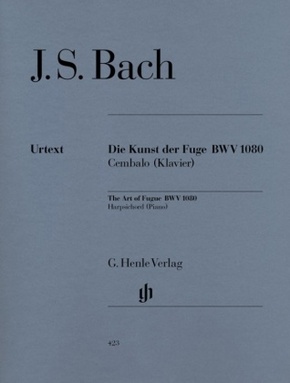
Johann Sebastian Bach - Die Kunst der Fuge BWV 1080 - Besetzung: Klavier zu zwei Händen
| Verlag | Henle |
| Auflage | 2000 |
| Seiten | 129 |
| Format | 31 cm |
| Gewicht | 524 g |
| Reihe | G. Henle Urtext-Ausgabe |
| ISBN-13 | 9790201804231 |
| Bestell-Nr | 13620148BA |
Bach musste die Kunst der Fuge bei seinem Tode unvollendet hinterlassen. Genau an der Stelle, an der die letzte Fuge abbricht, schreibt C. Ph. E. Bach in das Manuskript des Vaters: "Über dieser Fuge, wo der Name B.A.C.H im Contrasubject angebracht worden, ist der Verfasser gestorben." Unser Herausgeber Davitt Moroney bringt die Fuge mit 30 ergänzenden Takten zum Abschluss.
Viel wurde darüber gerätselt, welche Besetzung für das Werk wohl zutreffend sei, zumal Bach die Einzelstimmen in Partituranordnung schreibt und keine Angabe zur Ausführung macht. Sicherlich lassen sich strenge Fugen in jedweder Besetzung spielen. Das ist auch von jeher gang und gäbe. Es ist aber doch auffällig, dass der Zyklus ohne weiteres auf dem Cembalo oder Klavier gespielt werden kann. Für die Aufführungspraxis müssen keinerlei Anpassungen vorgenommen werden: ein starkes Argument für das Tasteninstrument.
Inhaltsverzeichnis:
Die Kunst der Fuge BWV 1080Contrapunctus I-XIV BWV 1080Canons in Hypodiapason, alla Decima, alla Duodecima, in Hypodiatessaron BWV 1080Anhang: Contrapunctus XIII in der Fassung für zwei Cembali BWV 1080
Bach's death meant that the Art of Fugue was left unfinished. In his father's manuscript Carl Philipp Emanuel noted exactly where the last fugue of the Art of Fugue broke off: "While working on this fugue, in which the name BACH appears in the countersubject, the author died." Our editor Davitt Moroney brings the fugue to a close with 30 supplementary measures.
There has been frequent speculation about what type of scoring would be most appropriate for the piece, particularly since Bach wrote the individual parts in score form and left no information about instrumentation. Certainly, strict fugues can be found in any ensemble scoring; this had been normal for centuries. It is remarkable, though, how the cycle can easily be played on the harpsichord or piano - a strong argument for keyboard performance.
Inhaltsverzeichnis:
The Art of Fugue BWV 1080Contrapunctus I-XIV BWV 1080Canons in Hypodiapason, alla Decima, alla Duodecima, in Hypodiatessaron BWV 1080Appendix: Contrapunctus XIII in the version for two Harpsichords BWV 1080
